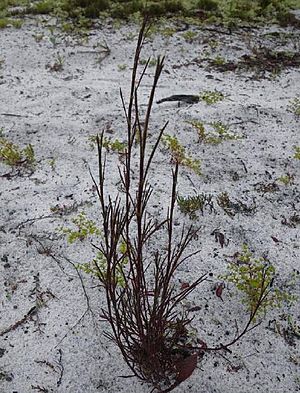Wireweed facts for kids
Quick facts for kids Wireweed |
|
|---|---|
 |
|
| Conservation status | |
| Scientific classification | |
| Synonyms | |
|
Polygonum basiramia is a special flowering plant. It is also known as wireweed or Florida jointweed. This plant is very rare. You can only find it in Florida, USA. It grows on the central ridges of the peninsula, like the Lake Wales Ridge. Sadly, its home is shrinking and getting damaged. Because of this, it is listed as an endangered species in the United States.
Contents
What is Wireweed?
This plant is a type of perennial herb. This means it lives for more than two years. It usually grows about 30 to 80 centimeters (about 1 to 2.5 feet) tall. Its roots can spread out far underground. The stems are thin and look like wires. They can also grow under the soil.
Wireweed only has leaves for a short time. These leaves are long and thin. They are usually no more than 2 or 3 centimeters long. The stems and leaves can be red or green.
Flowers and Reproduction
This plant has both male and female parts. Some plants have flowers with both male and female parts. Other plants only have female flowers.
The flowers grow in clusters called an inflorescence. These clusters are 1 to 3 centimeters long. The tiny flowers are white to pinkish. They are less than 2 millimeters long.
Wireweed usually blooms around September. It can produce fruit until December. Tiny bees called Perdita polygonellae help pollinate the flowers. These bees specialize in plants like wireweed. Some wasps also help with pollination. Female plants make many more seeds than plants with both male and female parts. The seeds are very, very tiny.
Special Abilities
Wireweed seems to be strong against certain chemicals. These chemicals are released into the soil by a plant called Florida rosemary. This ability is called allelopathy. It means one plant can affect the growth of another.
How Wireweed Got Its Name
The wireweed plant was first described in 1820. This was done by a scientist named John Kunkel Small. He first named it Delopyrum basiramia.
Later, it was moved to a different group of plants. This group was called Polygonella. So, its name became Polygonella basiramia. But in 2015, scientists studied the plants' DNA. This is called molecular phylogenetic studies. They found that Polygonella should be part of the Polygonum group. So, the plant's official name is now Polygonum basiramia.
Where Wireweed Lives
Wireweed is part of the Florida scrub plant community. This is a special type of habitat in Florida. It grows in areas with Florida rosemary, sand pine, and different types of oaks.
The soil in these areas is mostly sand. It does not hold much water or nutrients. Wireweed grows in open spaces within the scrub. These open spaces are kept clear by natural wildfires.
Neighboring Plants
Many other unique plants live in this habitat. Some of these include Clinopodium ashei, Cnidoscolus stimulosus, and Eryngium cuneifolium.
Protecting Wireweed
Wireweed faces several threats. Its habitat is being destroyed. This happens when land is changed for homes or farms. Growing citrus fruits is one reason for this.
Off-road vehicles also harm the habitat. They can damage the plants and soil. Also, stopping natural fires can hurt wireweed. This plant needs open areas that fires help create. Even though it needs fire, it might not depend on it as much as other Florida scrub plants.
Current Status
Many plants in this area are rare. This is because their habitat is broken up into smaller pieces. This is called habitat fragmentation. Wireweed is one of the more common rare plants. It can be found in large numbers in some places.
In 2010, there were 119 known places where wireweed grew. Scientists estimated over a million individual plants. However, it lives in a very endangered habitat. This means it is still at risk of disappearing.


